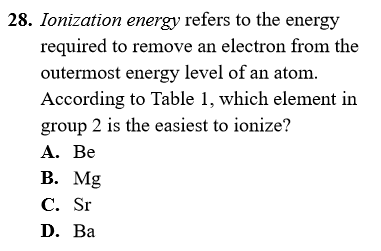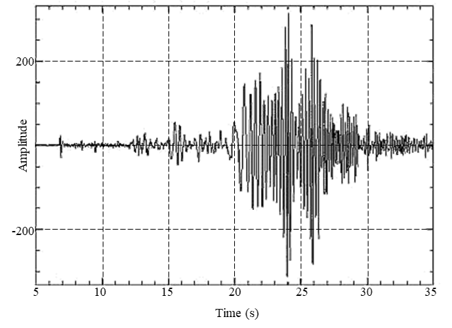The science test has tons of big words and confusing science topics. But don’t be scared! You will actually be tested on your reading and analyzing ability much more than your science understanding. So, you often know everything you need to solve those seemingly hard questions. The answers are in the passage somewhere, you just need to find them!
Italicized words often mean that the testmakers don’t expect you to know what that word or phrase means. Instead, they will define the word immediately after introducing it to you. If a word is italicized in a question, that is where you have to look to find out what it means; you will not find it in the passage! Look at the example below and see if you get the hang of the idea.

As you can see in this example, the term “ionization energy” is italicized and immediately defined within the question. Remember, you will most likely not see that word anywhere in the passage since it is italicized in the question!
Annotate the questions to understand them better. Learn how to do this effectively by reading the chapter [Time management]. It is usually more effective to annotate the questions rather than the passages!
You should start a passage by skipping straight to the questions instead of reading the passage. Questions take you to specific parts of the passage, so you should pretty much understand the whole passage by the time you finish reading all the questions.
Do not be afraid to make educated guesses! Just be sure that you only do so after you have attempted to cross out or narrow down the answers.
Make sure to use all the information and numbers that you are given in a question. If you notice that you have not used a number or bit of information, you might be missing something.
Always consider answers like “cannot be determined” or “not enough information” as possible answers. Unlike in-school tests, these answers are never thrown in just to fill up the list!
Whenever you get stuck on a question, it is a great practice to look at the answers and get an idea of what the question wants you to find. Below is an example of a question that might seem confusing at first, but contains answers that help you figure out what your solution should look like.

This question asks you to predict whether the graph will change and then provide an explanation as to why your answer is correct. There’s a lot of data in this question, and skimming the answer choices lets us know where to focus: on the y-axis of the graph. This type of question is very common, so be prepared to see lots of them!
Be sure that the first thing you look at on a graph is its axes. For a table, it should be the column/row labels. This will help you understand the more “difficult” figures of the test without having to be familiar with them. Look at the example below and try to figure out why most students find this graph difficult to use.

Did you notice that the -axis of this graph is pH? This requires you to remember that an acid has a low pH and a base has a high pH. This detail doesn’t make the graph any more “difficult” to use, it just requires you to recall this information before using it in the context of the question.
Read the axes! That’s the key strategy that will turn this “difficult” figure into an easy one.